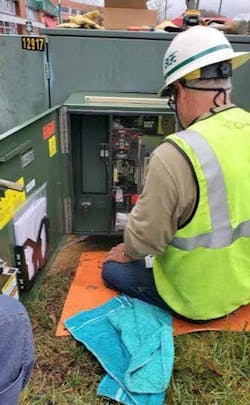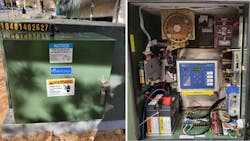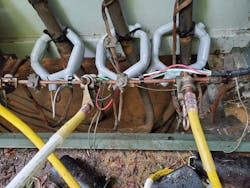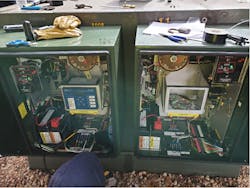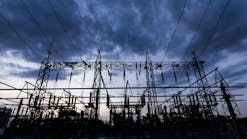The quest for improvement can be challenging. For many years, Baltimore Gas and Electric Co. (BGE) invested heavily in distribution automation (DA) and the restoration of overhead feeders. Now, the utility has turned its attention to underground feeders, which were minimally included in its DA plan up until recently because of costly market solutions.
Overhead feeders are hit constantly by severe weather, wildlife and even human-caused events. To minimize the impact of these events on customers, BGE invested in the automation of overhead feeders. Overhead DA reclosers provided the most benefit to customers because of their communication and quick-restoration capabilities. For underground feeders, things are quite different as weather and wildlife events rarely impact cables. However, when something happens to an underground feeder, the impact can affect a larger portion of customers.
After the installation of a few thousand overhead DA reclosers in BGE’s 13-kV distribution system over two decades, the overhead feeders became more automated than the underground feeders, because of the amount of segmentation created and auto-restoration abilities. In comparison, during that same time frame, BGE installed a few hundred DA reclosers in underground feeders, so the amount of segmentation created was smaller. With its overhead feeders now more reliable, the utility sought to improve the reliability of its underground feeders.
Motor-Operated Switchgear
While reliability was the main reason BGE focused more on its overhead DA reclosers, another reason was the higher cost of underground equipment and installation. The utility needed a cost-effective solution to improve its underground feeders.
The introduction of the Elastimold molded vacuum interrupter (MVI) and G&W Electric Co. Trident devices at BGE enabled the sectionalization of some underground feeders, but — with no DA capabilities — these devices still required manual on-site intervention. The S&C Electric Co. padmount IntelliRupter was the next natural step for the utility because of its DA capabilities. However, size and cost made it difficult to implement quickly and at large scale. It was an acceptable solution in the counties, but it was nearly impossible to install in the city, where space is limited.
The utility knew it could limit outages to fewer affected customers by adding more DA devices underground. This is when BGE started working with Cleaveland/Price Inc. to adapt the company’s existing PAD product to the utility’s needs. Starting from the original PAD, the BGE team worked with Cleaveland/Price to introduce a series of changes that would make the device compatible with the utility’s existing S&C and Hubbell Power Systems Inc. PME switchgear. The goal: Make the PAD behave as a load-monitoring, fault-detector device and be able to operate the equipment remotely.
BGE calls this solution motor-operated switchgear (MOS), as one or several of the 600-A legs of the PME switchgear can be remotely operated. The solution consists of several components that work together to achieve the goal. The main advantage of this device is it can be installed on new equipment but also retrofitted with existing switchgear. The ability to use existing assets provides cost savings to customers. Also, because of its small footprint, MOS is an acceptable solution in the city, where space is a challenge. Lastly, it is a solution that works for both types of switchgear that BGE uses, enabling the utility to keep its current switchgear vendors.
Developing the MOS
Beginning with the original PAD, both BGE and Cleaveland/Price teams held a series of meetings that included a mockup installation at BGE’s facilities to determine the changes needed. One of the concerns was the PAD hangs on a bracket installed after removing the small side door used to access the shaft that operates the blades of the switchgear. Any sensors to be installed would require using an exposed conduit that could be damaged over the years. The solution was to extend the existing cabinet enclosure to reach the cable connection compartment of the switchgear. By making a hole in the side of the switchgear cabinet, utility personnel could access the cable compartment, eliminating the need for an exposed conduit.
The original PAD normally is supported by the bracket installed on the side door. BGE’s extended cabinet raised concerns about additional torque on the bracket. To solve for this, two additional bolts were installed in the extended cabinet that protrude into the switchgear cable compartment and are secured with locking nuts.
The next step was deciding on the controller to use. A reliable, programmable device was needed that could control more than one of the 600-A legs. After reviewing several options, BGE’s team settled on the SEL-2411 Programmable Automation Controller series relay. The number of inputs and outputs plus the option to connect six current transformers (CTs) made it a perfect fit for BGE’s application. It also has enough programmable options to achieve the utility’s load-monitoring and fault-detection needs.
The SEL-2411 was programmed to communicate in a similar way as BGE’s DA reclosers. The main idea was to provide operators with similar tools to use during fault conditions as well as providing comparable data for future feeder planning. Fault detection required some additional complex programming. The device needed to differentiate faults on secondary circuits (behind a fuse, for example) from main line faults. In addition, it needed to provide separate information between momentary and sustained faults while also enabling reclosing to occur without sending alarms for each event.
BGE’s team created the programming and tested it in the utility’s DA lab. After several iterations, all the requirements were met. The controller provides load monitoring for up to six phases as well as fault targets for each phase. It also distinguishes between a momentary and a sustained fault. BGE decided to report on sustained faults only, as it already captured data for momentary faults using fault-interrupting equipment.
Load monitoring and fault detection are only possible when measuring currents. BGE’s team selected a split-core CT for its simple and easy installation. Installing a regular CT would involve disconnecting cables from the switchgear and redoing terminations. This labor-intensive process would make the MOS installation more complex, as a different group of underground experts would need to be present; more expensive, requiring more materials and labor costs; and longer, as another crew would be required to work on the equipment.
Together, all these decisions enabled BGE to achieve its goal of load monitoring, fault detection and remote operation. The utility found a way with Cleaveland/Price to use one main cabinet with the controller and communication equipment and interconnect a second cabinet that also could be controlled.
The Biggest Challenge
BGE’s biggest challenge has been the power required for charging the battery that allows the device to continue working during an outage. Power also is required for the electronic components that make the MOS operate as intended, such as the relay and communication equipment. The utility’s current approach is to connect an existing nearby padmount or overhead transformer with 120 V secondary to the MOS. On the positive side, it provides an inexpensive way to obtain the power required; however, there are only a few available locations. Installing a new transformer would mitigate this issue and is an option BGE will consider as needed.
The utility also is investigating self-contained secondary power solutions, such as using a potential transformer (PT) to power the device. So far, this has not moved forward because of technological constraints (like weight, size and cost), but the utility continues to explore this approach with vendors.
Customer Satisfaction
Currently, the MOS device provides load information while alerting operators of faults in the feeder and in which phase a fault is. When a fault occurs, operators can remotely isolate different sections, depending on the fault location, using not only the MOS devices but also DA reclosers and communicating fault indicators.
This overall view of the feeders has enabled the utility to restore power more quickly after outages and helped to position BGE as one of the top utilities in J.D. Power’s 2020 electric utility residential customer satisfaction study.
G&W Electric Clarification: Trident devices at BG&E enabled sectionalization of some underground feeders, but – as BG&E chose not to include Trident’s DA capabilities – these devices still required manual on-site intervention.
Jose Abi Karam Duran has worked at Baltimore Gas and Electric Co. for over 5 years and is currently in the T&S Engineering Projects area as a senior engineer. Prior to that, he worked as a senior engineer in the distribution automation (DA) group, where he performed coordination studies for DA reclosers and implemented sensor technology. He focuses on grid automation and intelligent devices. He studied electrical engineering at the Universidad de Carabobo in Venezuela and obtained his master’s degree in power and energy systems from New Jersey Institute of Technology in Newark New Jersey.
For More Information
Cleaveland/Price | www.cleavelandprice.com
G&W Electric | www.gwelectric.com
Hubbell | www.hubbell.com
S&C | www.sandc.com

